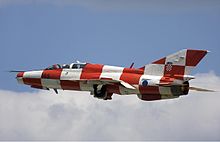Croatian Air Force
It was formed by the pilots of the aero-clubs of Sinj and Split; Matko Raos, Goran Kovačević, Nediljko Ivačić and Mladen Krstulović, as well as the then secretary of the Secretariat for National Defense of the Municipality of Sinj, Branimir Petričević, and the operator of material and technical means in the same Secretariat, Neven Bazina, formed an air combat group.From the beginning of the war until February 7, 1992, the platoon operated with the 4th Guards Brigade, when the first department fell under the Croatian Air Force, and the second remained with the guardsmen.The Independent Air Platoon Osijek supplied weapons and medical supplies to the defenders of Vukovar and carried out attacks on enemy positions during the battle of Vukovar with improvised bombs (the so-called boiler bomb), inflicting great moral and material losses on the Yugoslav People's Army and the Serbian paramilitary formations.The first combat operations are carried out with ultralight aircraft, which, armed with eight bombs of 3–4 kg caliber, of domestic design, attack from low altitudes at dusk or at night.Due to the enemy's air defense and the limited capabilities of the aircraft, all flights were carried out up to 50 meters in altitude and in the greatest secrecy.Armaments and equipment for the Croatian Air Force were purchased abroad in secret operations – namely, it was forbidden to export weapons to the territory of the former Yugoslavia affected by the war – they were purchased abroad; in the first place, Soviet-made combat aircraft were acquired for the handling of which Croatian pilots and technical personnel were trained during their earlier service in the JNA.The first 3 fighter planes were flown to air bases under the supervision of the Croatian authorities by former JRZ pilots: Danijel Borović, Ivica Ivandić and Ivan Selak.In late 1993 and early 1994, 40 MIG-21 aircraft produced between 1972 and 1980 were acquired from the former Central Asian republics of the USSR, of which 24 were included in the squadrons and 16 were used as spare parts supplies.Other sources claim that the procurement of weapons and aircraft - including transport helicopters of Soviet origin - was carried out in covert operations through connections in Russia.[8][9] After more than 10 years in the Croatian service and great success in Operation Storm, the government finally decided to retire a squadron of seven Mi-24V helicopters in 2005 due to a costly modernisation.After a horrible fire season during the summer of 2007 (12 firefighters lost their lives on a small island of Kornati), Croatia agreed to buy two new Canadair CL-415 and five Air Tractor AT-802 water bombers.[27][28] Croatia has so far procured a total of four UH-60M Black Hawk helicopters as part of a project for the equipment of the Croatian Armed Forces, which started in December 2018 in cooperation with the US government.As Croatia was no longer facing any military threat, serious talks were started with Israeli firms to extensively upgrade the fleet of 24 MiG-21bis/UM fighters to a "Lancer 3" standard instead of buying a completely new combat aircraft.Such plans were put into question by the global economic crisis which severely affected the Croatian economy and in late 2010 it was officially unveiled that no new aircraft were envisaged to enter service.The Defence Ministry finally announced in June 2013 that the Ukrainian firm Ukrspecexport will provide Croatia with 8 single-seat and 4 twin-seat upgraded MiG-21 aircraft.[33][34] In July 2017, the Croatian Ministry of Defence announced it had restarted the MiG-21 replacement procurement program, and issued a request for proposals for up to 12 aircraft to five countries: Greece, Israel and the United States for the General Dynamics F-16 Fighting Falcon, Sweden for the Saab JAS 39 Gripen, and South Korea for the KAI T-50 Golden Eagle.[36][37] In November 2017, Croatian media announced the offers from Sweden for the Saab JAS 39 Gripen and Israel for a mixed-fleet of A/B and C/D General Dynamics F-16 Fighting Falcon variants had been downselect from the four received letters of intent.[41] On 29 March 2018, the Croatian Government unanimously adopted a decision on the procurement of 12 F-16 C/D Barak Block 30 aircraft from Israel for 2.9 billion kunas (around 420 million euros).On 29 December 2018, Večernji list reported that the Croatian government unofficially bailed out of the tender leaving Israel and the United States to work out their dispute.[48] In late May 2021 Prime Minister Andrej Plenković announced the purchase of twelve used French Dassault Rafale aircraft to replace its MiG-21 fighters.









Croatian Air Force (Independent State of Croatia)CroatiaAir forceAerial warfareCroatian Armed ForcesPleso Air BaseCroatian War of IndependenceSiege of DubrovnikOperation MaslenicaOperation Winter '94Operation FlashOperation StormBosnian WarOperation Mistral 2Major GeneralGeneralImra AgotićBrigadier GeneralRudolf PerešinRoundelFin flashFighterRafaleHelicopterMi-171Bell 206TrainerTransportCL-415AT-802CroatianbranchRepublic of CroatiapilotsHistory of the Croatian Air ForceNational Guard CorpsYugoslav Air Force4th Guards BrigadeOsijekVukovarbattle of VukovarYugoslav People's ArmySerbian paramilitary formationsUTVA 75M79 OsatransmitterMiG-21UkraineCentral AsianRussiaMi-24 combat helicoptersUkrspecexportKnin FortressChief of the General StaffMi-24VGeorgiaMi-171sOH-58DMi-17sMi-8MTV-1UH-60LAntonov An-32BparatrooperNATO Quick Reaction AlertBell 206B-3 JetRangersZlín Z 242LtrainersUTVA 75sPilatus PC-9Maerobatic teamKrila Oluje / Wings of Stormhorrible fire season during the summer of 2007KornatiCanadair CL-415Air Tractor AT-802water bombersMediterraneanSloveniaWings of StormMi-171ShRussiannight vision devicerocket launchersAfghanKosovoOH-58D Kiowa WarriorUS ArmyAGM-114 HellfireAdriatic SeaUH-60M Black HawkUS governmentMinnesota Air National Guard91st Air Force BaseDassault RafaleUH-60M93rd Air Force BasePodvornicaIntegrated Air Defence SystemCroatian Coast GuardMount SljemeBorinciMount RotaAN/FPS-117RomaniaAerostarglobal economic crisisCroatian Ministry of DefenceGeneral Dynamics F-16 Fighting FalconSaab JAS 39 GripenKAI T-50 Golden EagleCroatian Governmentflight simulatorsIsraelTrump administrationUnited States CongressVečernji listCOVID-19 pandemicCroatian parliamentary electionSwedish JAS Gripen C/DMario BanožićAndrej PlenkovićFrench Air and Space ForceMont-de-Marsan Air BaseDefense Conseil InternationalCroatian-FrenchPilatus PC-21